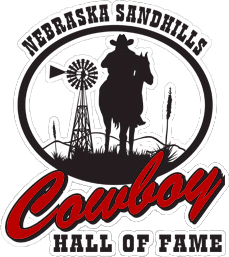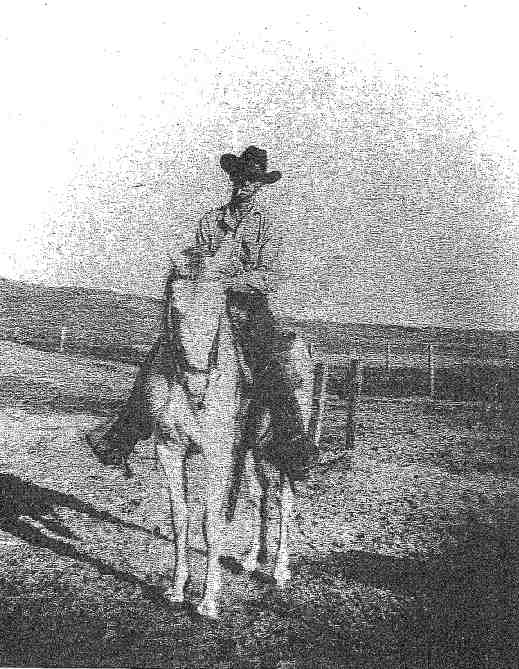August 24, 1914 – July 4, 1994
Bernard Edwin McKillip was born August 24, 1914, at Lund, Cherry County, Nebraska to Maggie Leora (Swiggart) and Dennis McKillip. He had three brothers, Russell, Richard and George and three sisters, Crystal, Coral and Audrey. They lived on a ranch near Merriman, Nebraska, until he was about 12 years old. He had just completed the 8th grade when his mother, he and his siblings moved to a ranch near Hyannis, Nebraska. After the move he began to hire out as a cowboy to assist in the support of his family. He initially worked for Ralph Swiggart, his uncle, and when that employment ended, he continued to seek employment as a cowboy with anyone who would hire a young man barely in his teens. He learned to break and train his own horses and could rope with the best of the men on the ranches. He often recalled one horse that he broke and rode for many years. He said every time he saddled the horse for a day’s work, the horse bucked from the barn all the way through the ranch yard to the pasture. The other cowboys would whoop and holler, throwing their hats at him, adding to the horse’s natural tendency to buck. As long as Bud owned this particular horse, he bucked for his initial ride of the day, providing the early morning entertainment for the other cowboys on the ranch.
Bud joined the CC’s for a short period of time and assisted in planting the trees in Halsey National Forest. He was always proud of having helped establish the forest.
He always had a great sense of humor and was always ready to take a dare. One time when he was helping on a cattle drive, one of the cowboys saw a bobcat and bet him he couldn’t rope it. Of course he roped it, had no desire to drag it and kill it, but he could not get his rope off the bobcat. Every time he would slow down and try to loosen up the rope, the bobcat would try to jump onto his horse. Of course none of the other cowboys volunteered to help him out of his predicament, so he just had to keep riding until the bobcat got worn out and he could loosen the rope and flip the loop off the bobcat.
He worked at many different ranches over the years, including the 7HL, White Water Ranch, McGinley Ranch, Farrar’s Ranch and the Bailey Ranch. He lived near Tryon, Ringgold, Stapleton, Arthur, Maxwell and Mullen, Nebraska and LaGrange, Wyoming. Exact time periods that he was employed by each ranch are unknown.
While he was working at the McGinley Ranch and was in the bunkhouse laying on his bed and looking out his window, he saw a good looking new cook walk by and he said to the other cowboys in the bunkhouse, “Come and look. There walks the gal I am going to marry”. They all had a good laugh about that, why would some good looking gal like that want to marry him. It took him several years, but on December 4, 1940 he finally did convince Marie Musil to marry him. While at the McGinley Ranch, he not only performed cattle work, he also assisted in the haying with horse drawn equipment.
In the early years of Bud and Marie’s marriage, Bud competed in bulldogging contests in the local rodeos. He was quite successful but his new wife did not enjoy watching her husband participate in the rodeos, and when their first child was born in 1943, he agreed to become a full time husband and father and gave up his love of bulldogging.
Bud broke and trained many horses and also took great pleasure in buying and selling horses. He sold many well-trained horses to other cowboys and always said every horse he had was for sale if someone wanted to pay enough money. He had some horses that he tried to break that he ended up selling as bucking stock for rodeos. He always got a thrill when he saw one of the horses he had tried to break become good bucking stock in the rodeo. He would say “That was a horse I bought for my kids but just couldn’t quite get him gentled down enough for them.”
In the late 1940’s, Bud organized the Tryon Roping Club. The members of the club practiced roping in an arena east of Tryon, Nebraska. Many times the horses were only green broke, so they rode their horses from home to the arena to wear them down enough to compete in the roping contest, and the calves that were used in these roping contests were fresh off the range and rarely had been roped before. A local contest was held each year to determine which five members would represent the club at the Trophy Roping. In 1949 the Tryon Roping Club was represented by Ken Renwald, Wayne Miller, Marion Miller, Jerry Lancaster and Bud McKillip. They competed against clubs from Lincoln County, Wellfleet, Sutherland and Paxton. The Tryon Roping Club won the trophy that year. The club was finally disbanded sometime after 1954.
Bud always knew that his horse was the most valuable piece of equipment he owned. A cowboy is only as good as his horse. He always took good care of his horses, kept them “fat and sassy”. After a hard day’s work, he made sure they were given grain and were rubbed down so they would be ready for another long day’s work the next day. He did not tolerate neglecting his horse, and once quit a job because he was told he could not grain his horse after a day’s work.
In approximately 1954 Bud began working at the Bailey Ranch north of Maxwell and worked there until about 1974. He was manager of a 16 section ranch and had not only cattle to tend, but fencing to build and repair and mowed and stacked all the hay that was used throughout the year for the cattle and horses. During the summer he hired high school age boys to assist with the haying operations. Some of the boys had never been out of town and through the summer they learned to operate and maintain a tractor, build fence, the importance of following directions, checking equipment and putting in a day’s work to earn their pay. Many young men returned as they began their careers and told him that he had taught them how to “be men” and they had learned how to work, be responsible for their equipment, take pride in their job and perform it to the best of their ability.
Throughout his lifetime, he spent time encouraging aspiring cowboys. He gave many young cowboys their first pair of spurs, saddle or first rope. He did whatever he could to give them a start in learning to love being a cowboy. One young man to whom Bud gave a rope was Harry Haythorn when he was about 5 years old.
Bud was always ready to assist a neighbor or friend when they needed help branding, moving cattle or any other task. He believed the day started before sunup and usually was in the pasture ready to begin rounding up by daybreak. He rarely called a veterinarian for assistance. He roped and doctored cattle in the pasture if possible, and if not, he drove them to the ranch house and treated them there. He pulled many calves, even performed a caesarean if necessary. He didn’t always save the cow and calf, but frequently saved either the cow or the calf, and this made it successful. By the time a vet came from town (50 miles round trip), performed the surgery and maybe still lost the cow and calf, it wasn’t financially feasible to call for help. He did whatever was necessary and improvised with what he had in order to accomplish the task at hand.
In later years after he retired, he still continued to teach aspiring cowboys. He was living east of Bridgeport and was well into his 70’s when a young neighbor man called and asked if Bud could tell him how to castrate colts. Bud instructed him over the phone on how to perform the castration, stressing the need to keep things sanitary in order to reduce infection, as well as getting the horse up and walking to increase the success of the castration. This young man went on to have a large horse herd and performed all his own castrations. He readily tells people how he saved a lot of money because he learned to perform castrations over the phone through an old cowboy’s instructions.
Bud served as a 4-H horse showmanship judge in North Platte, Nebraska for several years and continued to assist youngsters with increasing their knowledge of horsemanship. He enjoyed watching young people develop their skills in both riding and training horses, and was always disappointed in the young men and women who competed on horses that were purchased by their parents already fully trained.
Ill health forced him to sell his acreage near Bridgeport and move closer to his daughter in Gering, Nebraska, in 1993. He never adjusted to living in town and often said “There’s nothing to see but another house, not a horse or cow in sight.”

